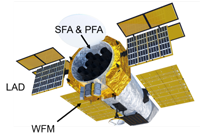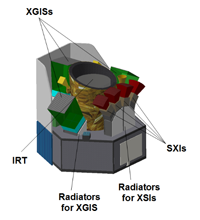
![]() The goal of the proposal "Studies of neutron stars, black holes and related transient phenomena using stronomical satellites" is to enable participation of Poland in the planned astronomical satellites eXTP (enhanced X-ray Time and Polarimetry) and THESEUS (Transient High-Energy Sky and Early Universe Surveyor). On one hand, it will be scientific contributions to the development of the fields of physics and astrophysics related to the objectives of the missions. This part of the research work is performed by scientists at the Nicolaus Copernicus Astronomical Centre of the Polish Academy of Sciences (PAS). On the other, it will be contributions to the design and building of the instruments that will be mounted on board, and will enable the scientific observations. This activity will be carried out by engineers at the Centrum Badań Kosmicznych PAN. The involvement of the Polish team in instrument building will be essential for Polish scientists to play a serious decision-making role in the observation planning and direct access to the results of the observations.
The goal of the proposal "Studies of neutron stars, black holes and related transient phenomena using stronomical satellites" is to enable participation of Poland in the planned astronomical satellites eXTP (enhanced X-ray Time and Polarimetry) and THESEUS (Transient High-Energy Sky and Early Universe Surveyor). On one hand, it will be scientific contributions to the development of the fields of physics and astrophysics related to the objectives of the missions. This part of the research work is performed by scientists at the Nicolaus Copernicus Astronomical Centre of the Polish Academy of Sciences (PAS). On the other, it will be contributions to the design and building of the instruments that will be mounted on board, and will enable the scientific observations. This activity will be carried out by engineers at the Centrum Badań Kosmicznych PAN. The involvement of the Polish team in instrument building will be essential for Polish scientists to play a serious decision-making role in the observation planning and direct access to the results of the observations.

![]() The satellite eXTP is designed to study the behaviour of matter under extreme conditions in close proximity to black holes and neutron stars; namely, to investigate strong-field gravity, measure black hole masses and spins, and determine the equation of state of ultra-dense matter. THESEUS will study the early Universe via detection and analysis of early cosmic gamma-ray bursts, and will perform an unprecedented deep monitoring of the X-ray transient Universe.
The satellite eXTP is designed to study the behaviour of matter under extreme conditions in close proximity to black holes and neutron stars; namely, to investigate strong-field gravity, measure black hole masses and spins, and determine the equation of state of ultra-dense matter. THESEUS will study the early Universe via detection and analysis of early cosmic gamma-ray bursts, and will perform an unprecedented deep monitoring of the X-ray transient Universe.
![]() There will be four instruments on board eXTP, but our participations will concentrate on two: the Large Area Detector (LAD) and the Wide Field Monitor (WFM ). Detector LAD will achieve an effective area of ~10 m2 in the 2-30 keV range together with very high temporal and spectral resolution. It will yield unprecedented information on strongly curved space-times and matter under extreme conditions of pressure and magnetic field strength. The WFM will discover and localise X-ray transients and impulsive events and monitor spectral state changes with unprecedented sensitivity. On board THESEUS there will be three instruments, the Soft X-ray Imager (SXI), the X-Gamma ray Imaging Spectrometer (XGIS) and the InfraRed Telescope (IRT).
There will be four instruments on board eXTP, but our participations will concentrate on two: the Large Area Detector (LAD) and the Wide Field Monitor (WFM ). Detector LAD will achieve an effective area of ~10 m2 in the 2-30 keV range together with very high temporal and spectral resolution. It will yield unprecedented information on strongly curved space-times and matter under extreme conditions of pressure and magnetic field strength. The WFM will discover and localise X-ray transients and impulsive events and monitor spectral state changes with unprecedented sensitivity. On board THESEUS there will be three instruments, the Soft X-ray Imager (SXI), the X-Gamma ray Imaging Spectrometer (XGIS) and the InfraRed Telescope (IRT).
![]() The Polish eXTP collaboration will be responsible for the Instrument Control Unit and Power Distribution Unit (PDU) for the WFM and for the supply modules PSU/PDU for the LAD. For THESEUS, we will be responsible for the Power Supply Unit (PSU) for the spectrometer XGIS.
The Polish eXTP collaboration will be responsible for the Instrument Control Unit and Power Distribution Unit (PDU) for the WFM and for the supply modules PSU/PDU for the LAD. For THESEUS, we will be responsible for the Power Supply Unit (PSU) for the spectrometer XGIS.
![]() The eXTP mission has been formally approved for implementation by the Chinese Space Agency and entered phase B in 2019. The launch is planned for the year 2027. THESEUS passed the preliminary selection of the European Space Agency in 2018. ESA will decide about its final acceptance in 2021, and its launch is planned for 2032.
The eXTP mission has been formally approved for implementation by the Chinese Space Agency and entered phase B in 2019. The launch is planned for the year 2027. THESEUS passed the preliminary selection of the European Space Agency in 2018. ESA will decide about its final acceptance in 2021, and its launch is planned for 2032.